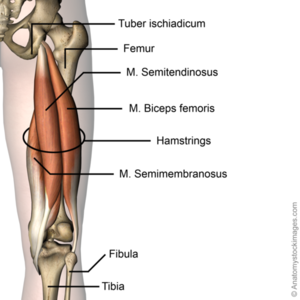Knee Flexors: Difference between revisions
No edit summary |
No edit summary |
||
| Line 8: | Line 8: | ||
== Sub Heading 2 == | == Sub Heading 2 == | ||
[[File:Hip-hamstring-hamstrings-semi-membranosis-biceps-femoris-semitendinosus-tuber-ischiadicum-back-skin-names.png|thumb|Hamstrings Group]] | |||
The semitendinosus, semimembranosus, and biceps femoris (long and short heads) make up the hamstring group. | |||
Spanning the posterior thigh, the hamstring muscles are the primary knee flexors. The hamstrings also perform hip extension, except short head biceps femoris. | |||
As the three of the four hamstrings cross the hip, as well as the knee, the position of the hip (and knee) can significantly affect the functional length of these muscles. As such, both the extensibility and the maximal force generated by the hamstrings are highly dependent on the position of the hip. | |||
== Sub Heading 3 == | == Sub Heading 3 == | ||
The gracilis and sartorius flex and internally rotate the knee and play an important role in providing stability to the medial side of the knee. They also have roles at the hip. These muscles attach proximally at the hip. Distally these muscles course posterior to the medial-lateral axis of rotation of the knee. The gracilis and sartorius tendons join the semitendinosus for a collective insertion on the proximal-medial tibia. The three tendons conjoin to form one common tendon, commonly known as the pes anserinus, a Latin term meaning “goose’s foot.” | |||
== Resources == | == Resources == | ||
Revision as of 05:54, 16 February 2022
Original Editor - Lucinda hampton
Top Contributors - Lucinda hampton
Introduction[edit | edit source]
The knee flexors include the set of hamstrings, gracilis, sartorius, gastrocnemius, plantaris, and popliteus. Most of these knee flexors also internally or externally rotate the knee[1].
Sub Heading 2[edit | edit source]
The semitendinosus, semimembranosus, and biceps femoris (long and short heads) make up the hamstring group.
Spanning the posterior thigh, the hamstring muscles are the primary knee flexors. The hamstrings also perform hip extension, except short head biceps femoris.
As the three of the four hamstrings cross the hip, as well as the knee, the position of the hip (and knee) can significantly affect the functional length of these muscles. As such, both the extensibility and the maximal force generated by the hamstrings are highly dependent on the position of the hip.
Sub Heading 3[edit | edit source]
The gracilis and sartorius flex and internally rotate the knee and play an important role in providing stability to the medial side of the knee. They also have roles at the hip. These muscles attach proximally at the hip. Distally these muscles course posterior to the medial-lateral axis of rotation of the knee. The gracilis and sartorius tendons join the semitendinosus for a collective insertion on the proximal-medial tibia. The three tendons conjoin to form one common tendon, commonly known as the pes anserinus, a Latin term meaning “goose’s foot.”
Resources[edit | edit source]
- bulleted list
- x
or
- numbered list
- x
References[edit | edit source]
- ↑ Mansfield PJ, Neumann DA. Essentials of kinesiology for the physical therapist assistant e-book. Elsevier Health Sciences; 2018 Oct 23. Available:https://www.sciencedirect.com/topics/neuroscience/knee-flexors (accessed 16.2.2022)







